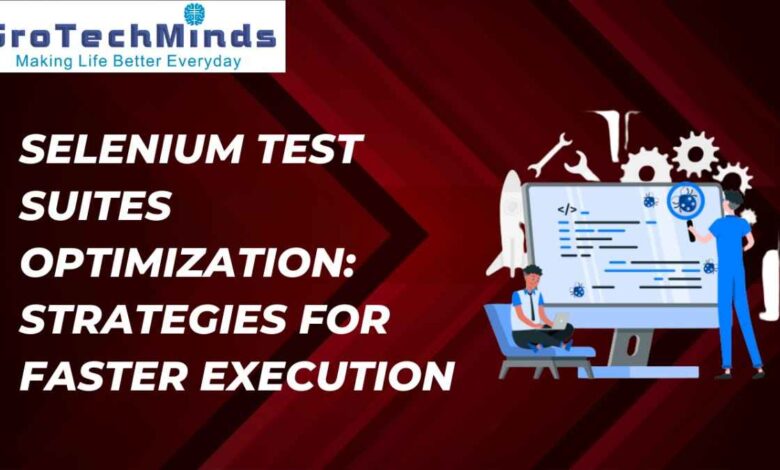Selenium Test Suites Optimization: Strategies for Faster Execution

Introduction:
Testers can create scripts to mimic user interactions with web pages using Selenium, a potent tool for automating web application testing. However, execution times can become a major bottleneck in the testing process as test suites get larger and more complicated. We’ll look at ways to speed up the execution of Selenium test suites in this blog post, which will increase productivity and efficiency in the testing process.
In parallel operation:
Parallel execution is one of the best methods for cutting down on the amount of time it takes to run the Selenium test suite. Parallel execution makes better use of the resources available by enabling several tests to run simultaneously on various browsers or devices as opposed to sequentially. Tests can be distributed across numerous nodes in parallel using Selenium Grid, a widely used tool that speeds up test suite completion.
Prioritizing Test Cases:
Test cases vary in significance and influence on the application. Test suite execution can be streamlined by ranking test cases according to important functionality, usage frequency, and possible influence on end users. Teams can reduce the total amount of time needed for testing by identifying key issues earlier in the development cycle by concentrating on high-priority test cases initially.
Improved Test Data Management
An essential component of Selenium test automation is test data management. Test execution times can be greatly impacted by the efficient production, manipulation, and cleanup of test data. During test execution, data retrieval can be improved and overhead can be decreased by utilizing lightweight data sources like in-memory databases or data fixtures. Further optimizing execution times can be achieved by minimizing redundant test scenarios through the use of approaches such as data-driven testing.
Optimization of Browser Configuration:
Optimizing browser settings can also help speed up the execution of Selenium tests. Reducing loading times and increasing test reliability can be achieved by adjusting browser settings, such as turning off browser extensions, deleting cookies and cache, and improving network conditions. Moreover, the graphical interface burden can be removed by using headless browsers like PhantomJS or headless Chrome, which leads to faster test execution without compromising test coverage.
Restructuring the Test Suite:
Test suite bloating and inefficiency can occur over time, slowing down test performance and requiring more maintenance. Restructuring test cases, getting rid of unnecessary or outdated tests, and optimizing the overall test design are all part of test suite refactoring, which improves efficiency and maintainability. Teams can gain faster execution speeds and improved scalability over time by decomposing large, monolithic test suites into smaller, more focused modules and minimizing dependencies between tests.
Integration of Continuous Integration and Deployment (CI/CD):
Feedback loops can be sped up and the testing process streamlined by integrating Selenium test automation into CI/CD pipelines. As part of the build and deployment pipeline, teams can automate the execution of Selenium test suites to detect and resolve issues early in the development cycle, thereby preventing regressions and guaranteeing consistent application quality. Selenium tests may be easily integrated into the CI/CD process with the help of tools like Jenkins, Travis CI, or CircleCI, which can speed up the production of high-quality software.
Infrastructure Efficiency:
Accelerating the execution times of Selenium tests can also be achieved by optimizing the underlying infrastructure. Purchasing strong hardware components, including multicore CPUs and lots of RAM, can lower processing delays and enhance test performance as a whole. Furthermore, by utilizing cloud-based testing systems like Sauce Labs or BrowserStack, parallel testing at scale may be accomplished without requiring a lot of infrastructure setup or maintenance due to on-demand access to a variety of browser and device configurations.
Constant Observation and Feedback Loop:
To find performance bottlenecks and places for additional improvement, it’s essential to set up a continuous monitoring and feedback loop in addition to optimizing Automation testing with Selenium suites for faster execution. By tracking test execution times, resource usage, and test failure rates with monitoring tools, teams may refine their approach and gain important insights into the efficacy of optimization efforts. Teams can increase the efficiency of their test suites continuously over time by iteratively refining their optimization efforts and asking testers and developers for feedback on test execution metrics.
Performance Tuning and Profiling:
The performance of automation testing in Selenium scripts and automation frameworks can be profiled and tuned to find areas where code improvement can be achieved. Reduce overall runtimes and expedite test execution by identifying resource-intensive activities, wasteful code patterns, and needless delays. Without compromising test coverage or reliability, strategies like code reworking, wait time optimization, and cache implementation can result in considerable gains in test suite efficiency.
Frequent Upkeep and Cleaning:
To keep test suites slim and effective, it’s critical to carry out routine maintenance and cleanup as they develop and application needs alter. Bloat can be avoided and optimal speed can be maintained over time by reworking out-of-date code, replacing deprecated dependencies, and removing unnecessary test cases.
In summary:
Enhancing Automation testing effectiveness and reducing web application time-to-market requires optimizing Selenium automation testing suites for quicker execution. Teams can achieve significant reductions in test execution times while maintaining high standards of test coverage and reliability by implementing strategies like parallel execution, test case prioritization, smarter test data management, browser configuration optimization, test suite refactoring, CI/CD integration, and infrastructure optimization. By adopting these optimization strategies, companies can provide high-quality software more quickly and effectively than ever before by streamlining their testing procedures.




